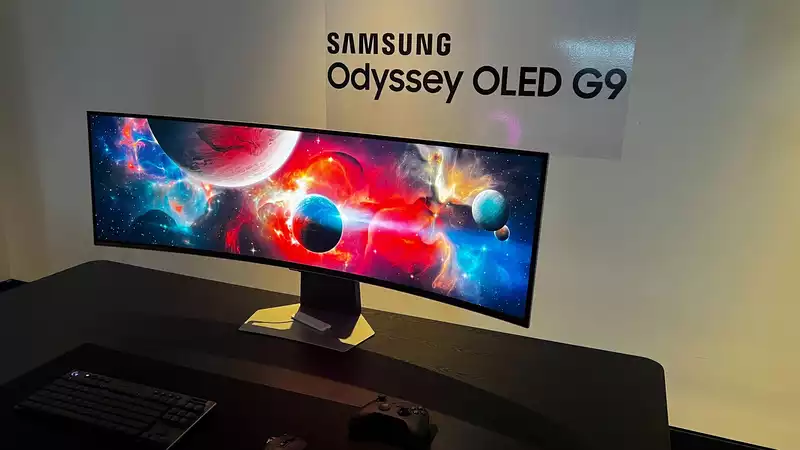Samsung has introduced OLED displays so huge that they seem to be swallowed up. But the Odyssey OLED G9 is about to completely take over your desk as the "world's first" 49-inch OLED monitor. I got to play around with Samsung's new OLED display for a while at a private hands-on event. And honestly, I think it's time to stop with the dual monitor setup and go wide.
The Samsung Odyssey OLED G9 is a 49-inch curved ultrawide with a 32:9 aspect ratio (5120 x 1440 resolution) and 1800R curvature The first thing you notice about the G9 (aside from its width) is how thin it is. The display is about 4.5 mm thick and takes up very little space, despite the fact that there is a lot of screen to look at.
The RGB light ring on the back of the display also features a trick called CoreSync, which allows the lighting to match the dominant color on the screen, creating a nice ambient lighting effect similar to that seen on GoVee's cool light kit or Philips TVs.The Odyssey OLED G9 is what is called a "dual quad HD" display, which is essentially like two 1440p monitors side by side. It also uses Samsung's Neo Quantum Processor Pro chip. This is an AI processing chip that uses deep learning to properly upscale images to resolution. This is a feature found in the Neo QLED line of 4K and 8K TVs, like the QN90B we checked out last year.
The G9 has a refresh rate of 240 Hz and a response time of 0.03 ms. This is on par with all gaming OLED displays currently on the market. It is a real pleasure to watch games like "Doom Eternal" and "Forza Horizon" in action, but it does take some getting used to as it can get a bit overwhelming after 20+ minutes of play.
One feature that has not received much attention is Multiview, which, unlike Odyssey Ark, allows multiple device sources to be displayed picture-by-picture. Even though I am not a fan of multitasking, I was able to split the display in half and play Forza on my PC on the right side, while streaming an episode of Conan on the TBS app from Samsung's media hub on the left side. In other words, I could have a streaming PC and a gaming console (or two PCs at will) side by side at once and not need a second display.
The Samsung Gaming Hub is also back, where you can download popular game streaming apps like Xbox Game Pass and GeForce Now. Even if your PC isn't rugged enough to play PC games at full 5120 x 1440 resolution, you can connect a wireless keyboard, mouse, and gamepad via Bluetooth so you can stream games anytime.
I'm not sure how someone can buy a $2200 gaming monitor and not have a high-end PC to go with it, but it's nice to have options, and you can install other streaming apps like Netflix and Hulu, etc. No TV tuner. It has almost all the features of a Samsung TV, except that it has no TV tuner.
Speaking of gaming, we played a few titles in 32:9, and while it felt strange at first, the games looked stunningly beautiful. To get an idea of the panel's picture quality, I played the beautiful and colorful platformer "Planet of Lana" and a few games of "Fortnite" and "Call of Duty." If you play RPGs or action-adventure games, you will be completely sucked in is obvious.
I will admit that a dynamic platformer like "Planet of Lana" does a better job of immersion than a shooter, mainly because the FOV of a shooter in this aspect ratio is very jarring and stressful. Also, if you play competitive games, you will most likely play them in 16:9. This is because then you don't have to constantly move your head to keep up with the action across the screen. As with any OLED display, the colors and contrast are breathtaking
and with hardware that supports it, games will display and play well. The gaming PC I used for my demo had an RTX 4080 GPU.
There is still the brightness issue. As you may know, the brightness of this generation of ultra-fast OLED panels is disappointing, hovering around 200 nits on average, lower than most non-OLED displays.
According to a Samsung representative, the average brightness of the G9 is around 250 nits, with a peak brightness of 400 nits. In my demo, the lights in the showroom were turned off and light-shielding curtains were put up to block out the sunlight that would normally fill the room, so it felt as if I was playing at night instead of daytime.
The Samsung Odyssey OLED G9 is currently available for pre-order for $2,199 and will ship at the end of the month.
.

Comments